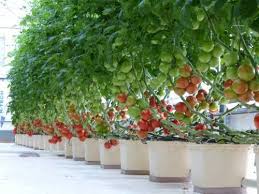Hydroponic Bucket System
You are on Page 7 of our ten page series on hydroponic bucket systems. Click on any of the below pages to jump to that page.
Page 1 Page 2 Page 3 Page 4 Page 5 Page 6 Page 7 Page 8 Page 9 Page 10

While many online hydroponic retailers offer package bucket deals, the buckets and components are also available individually or in variable quantities. This allows growers to purchase just what they need, and expand as they have the money to do so. Furthermore, this approach is not only popular in the USA; international retailers offer supplies too. The above buckets are available from IndiaMART. The specific product page is here.
Scalability
The bato bucket system is extremely and easily scalable. This is one of its great strengths. A grower who starts off with a few buckets to test the system, can easily expand up to several dozen, or even several hundred, using most of the same systems and management which kept the first few buckets going. That same grower, over time, could expand that bucket system into the thousands if his/her production goals warranted the expansion.
By a similar token, a grower could scale back a bucket system of thousands to hundreds, just as easily. The unused buckets could be stacked and stored for future use, or even sold. The extra irrigation lines and drain lines, if present, could be taken apart, drained and cleaned, then stored (or sold along with the buckets). In this latter instance, the grower may or may not be able to save the growing media. Some types of growing media, such as lava rock, hydroton, sand/gravel mixes and some rockwool types, can be cleaned, sterilized, dried and stored long term. Coir, vermiculite/perlite, and the smaller grades of rockwool suck as so-called croutons, are probably too fragile, and often inexpensive enough, to warrant the work required for storage.
The biggest issue involved in scaling up a bato bucket system is the nutrient solution reservoir or injector. For growers who are reducing a large system down to a smaller size, this is relatively easy. Injectors generally can simply be adjusted to keep the same nutrient ratios even with reduced flow volumes. For smaller systems using reservoirs, the reservoirs can either be kept filled and the nutrient solution recycled less frequently (because fewer plants will draw the nutrients down more slowly), or the reservoir will drain more slowly in a drain-to-waste system. Either way, any given system’s nutrient reservoir or injector can comfortably service a scaled-down version of the same system.
Scaling up is slightly more involved. For reservoir-based systems, the system can be expanded up to the capacity of the reservoir. If the grower anticipated the expansion and used a larger-than-necessary reservoir, then the reservoir will already be capable of handling the larger production. However, if a grower sized his/her original system without planning for expansion, then the existing reservoir is probably already near or at capacity. If the system is a drain-to-waste, the grower may still be able to rely on the existing reservoir, and cycle it more frequently. However, if the system recycles nutrient solution, then the expanded system would need a new reservoir.
For bucket systems which already use a nutrient injector, the injector may be able to provide for the expanded system with nothing more than a few adjustments, if any (depending on the injector). If the system is expanding by a lot, say becoming twice the current size, then the grower would want to examine the drip irrigation lines delivery system, and consider if perhaps larger manifolds are warranted to ensure equal delivery to all sections. Systems of this magnitude are normally large enough to already have employees which monitor the irrigation system and are qualified to make any needed adjustments. As such, they go beyond the scope of the information in this website, so we won’t belabor such large systems here.
Bottom line, a grower simply needs to ensure that any system expansion can properly deliver nutrients throughout the system by whatever means he or she is already using. If an expansion is going to be so large as to overwhelm the existing nutrient delivery system, the grower could use the expansion event to redo the irrigation delivery system for the entire operation, and quite possibly reap enough long-term cost savings to pay back at least some of the expansion. However, the best cost savings come from anticipating such expansion when first designing the system. This way, the bato bucket system can be built, deployed and gradually expanded over time, using an irrigation system which is already designed for the eventual maximum size.
In the grand scheme of things, most hydroponics methods have this same requirement regardless of growing technique (the raft system being the notable exception). So these issues would come up for almost all of them. The point to remember here is that, all things considered, bato bucket systems are easier to expand and contract than most. Keeping these issues in mind from the outset will help growers plan accordingly.
BACK NEXT
Click any of the following links to jump to that page:
Page 1 Page 2 Page 3 Page 4 Page 5 Page 6 Page 7 Page 8 Page 9 Page 10